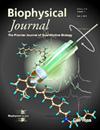FRET-FCS: Advancing Comprehensive Insights into Complex Biological Systems.
IF 3.2
3区 生物学
Q2 BIOPHYSICS
引用次数: 0
Abstract
Förster resonance energy transfer (FRET) is a short-range distance-dependent photophysical phenomenon that allows the measurement of intra- and inter-molecular distances through fluorescence detection. FRET measurements are sensitive to the movements of fluorescently labeled molecules as they produce fluorescence fluctuations. Fluorescence correlation spectroscopy (FCS) analyzes these fluctuations at faster and broader timescales (from picoseconds to seconds) compared to other techniques, unraveling the thermodynamic and kinetic properties of the system under study. Therefore, the combination of FRET and FCS (FRET-FCS) facilitates the analysis of molecular dynamics. Since its introduction (1), FRET-FCS has evolved into studying more sophisticated systems, requiring improvements in data acquisition and analysis. In this review, we discuss applications in the field of FRET-FCS that propose novel alternatives to overcome the inherent limitations of experimental setups. This work aims to promote using and enhancing FRET-FCS techniques to develop a comprehensive understanding of biological systems.FRET-FCS:推进复杂生物系统的综合见解。
Förster共振能量转移(FRET)是一种短距离依赖的光物理现象,可以通过荧光检测测量分子内和分子间的距离。FRET测量是敏感的荧光标记分子的运动,因为他们产生荧光波动。与其他技术相比,荧光相关光谱(FCS)以更快、更宽的时间尺度(从皮秒到秒)分析这些波动,揭示了所研究系统的热力学和动力学特性。因此,FRET和FCS的结合(FRET-FCS)有利于分子动力学分析。自引入以来(1),FRET-FCS已经演变为研究更复杂的系统,需要改进数据采集和分析。在这篇综述中,我们讨论了FRET-FCS领域的应用,提出了新的替代方案,以克服实验设置的固有局限性。这项工作旨在促进和加强FRET-FCS技术的使用,以发展对生物系统的全面了解。
本文章由计算机程序翻译,如有差异,请以英文原文为准。
求助全文
约1分钟内获得全文
求助全文
来源期刊

Biophysical journal
生物-生物物理
CiteScore
6.10
自引率
5.90%
发文量
3090
审稿时长
2 months
期刊介绍:
BJ publishes original articles, letters, and perspectives on important problems in modern biophysics. The papers should be written so as to be of interest to a broad community of biophysicists. BJ welcomes experimental studies that employ quantitative physical approaches for the study of biological systems, including or spanning scales from molecule to whole organism. Experimental studies of a purely descriptive or phenomenological nature, with no theoretical or mechanistic underpinning, are not appropriate for publication in BJ. Theoretical studies should offer new insights into the understanding ofexperimental results or suggest new experimentally testable hypotheses. Articles reporting significant methodological or technological advances, which have potential to open new areas of biophysical investigation, are also suitable for publication in BJ. Papers describing improvements in accuracy or speed of existing methods or extra detail within methods described previously are not suitable for BJ.
 求助内容:
求助内容: 应助结果提醒方式:
应助结果提醒方式:


